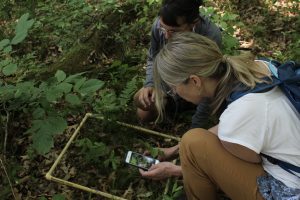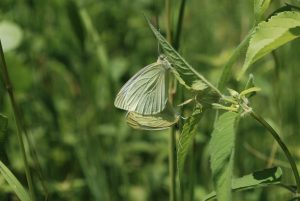 An underappreciated dimension of scientific research is collecting data. For ecologists interested in measuring biodiversity, a perennial issue is that counting plants and animals as they move, hide, and change is extremely difficult, leading to incomplete datasets that hinder our knowledge of the natural world.
An underappreciated dimension of scientific research is collecting data. For ecologists interested in measuring biodiversity, a perennial issue is that counting plants and animals as they move, hide, and change is extremely difficult, leading to incomplete datasets that hinder our knowledge of the natural world.
KBS professor and ecologist Dr. Alisha Shah ran into this problem when she sought to understand how climate change affects the diversity and abundance of insects year-by-year. Annual shifts in temperature and precipitation changes are likely to impact insects, but counting the number of insects in a forest would take months for a small group of scientists. So how can this colossal task be accomplished?
Citizen science, also known as community science, offers a method to increase the efficiency of data collection while engaging non-scientists in learning about the natural world. These methods harness public interest in ecology and natural history to collect an accurate and detailed dataset of all animals and plants present in a particular location.
BioBlitz at the Sanctuary
On June 17, 2023, local scientists, naturalists, students and community members gathered for a citizen science event called a BioBlitz, with a goal of surveying all the insects, birds, reptiles, amphibians, and plants in the Kellogg Bird Sanctuary. During the BioBlitz, over 100 participants and volunteers used the iNaturalist app to photograph, record and identify organisms found in the Bird Sanctuary.
 Participants were assigned to field teams that focused on the following organisms: birds (prairie/forest), aquatic insects, reptiles/amphibians, butterflies, dragonflies, forest insects, plants (prairie/forest), urban insects (i.e., those near human structures), bees, and ground insects. Each group was given equipment to aid in their search (nets, binoculars, magnifying glasses, etc.), and once an organism was found, participants used the image recognition technology of the iNaturalist app and the help of volunteer naturalists to record an accurate species identification.
Participants were assigned to field teams that focused on the following organisms: birds (prairie/forest), aquatic insects, reptiles/amphibians, butterflies, dragonflies, forest insects, plants (prairie/forest), urban insects (i.e., those near human structures), bees, and ground insects. Each group was given equipment to aid in their search (nets, binoculars, magnifying glasses, etc.), and once an organism was found, participants used the image recognition technology of the iNaturalist app and the help of volunteer naturalists to record an accurate species identification.
So far, BioBlitz participants have catalogued over 300 species of organisms living in the Bird Sanctuary – observations include cabbage white butterflies (pictured), a prickly pear cactus, a thistle tortoise beetle, painted turtles, and a nest of house wrens in a wooden post. Additional species are still being added – hundreds of insects were brought back to the lab and are still being identified using field guides a month later!
You can see the full list of species observations here.
Dr. Shah plans to repeat the BioBlitz annually over the next five years to help her research group understand how insect diversity is changing with the local climate, and to continue welcoming the public to participate in the challenging – but rewarding – work of collecting ecological data. We hope you’ll join in 2024!
~~~~~~~~~~~~~~~~~~~~
Nasser Mohammed and Corinn Rutkoski are Ph.D. students at the W.K. Kellogg Biological Station. Nasser is part of the Klausmeier Lab, and Rutkoski is part of the Evans Lab.
~~~~~~~~~~~~~~~~~~~~

A legacy of conservation; a commitment to sustainability.
Kellogg Bird Sanctuary12685 East C Avenue
Augusta, MI 49012
Phone: (269) 671-2510 birdsanctuary@kbs.msu.edu